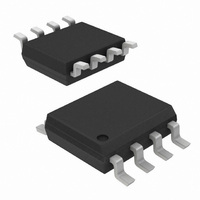ISL3179EFBZ-T7A Intersil, ISL3179EFBZ-T7A Datasheet - Page 9

ISL3179EFBZ-T7A
Manufacturer Part Number
ISL3179EFBZ-T7A
Description
IC TXRX RS485/422 ESD 8SOIC
Manufacturer
Intersil
Datasheet
1.ISL3179EIRZ.pdf
(17 pages)
Specifications of ISL3179EFBZ-T7A
Lead Free Status / RoHS Status
Lead free / RoHS Compliant
Available stocks
Company
Part Number
Manufacturer
Quantity
Price
Company:
Part Number:
ISL3179EFBZ-T7A
Manufacturer:
Intersil
Quantity:
250
Application Information
RS-485 and RS-422 are differential (balanced) data
transmission standards for use in long haul or noisy
environments. RS-422 is a subset of RS-485, so RS-485
transceivers are also RS-422 compliant. RS-422 is a
point-to-multipoint (multidrop) standard, which allows only
one driver and up to 10 (assuming one unit load devices)
receivers on each bus. RS-485 is a true multipoint standard,
which allows up to 32 one unit load devices (any mix of
drivers and receivers) on each bus. To allow for multipoint
operation, the RS-485 spec requires that drivers must
handle bus contention without sustaining any damage.
Another important advantage of RS-485 is the extended
common mode range (CMR), which specifies that the driver
outputs and receiver inputs withstand signals that range from
+12V to -7V. RS-422 and RS-485 are intended for runs as
long as 4000’ (~1200m), so the wide CMR is necessary to
handle ground potential differences, as well as voltages
induced in the cable by external fields.
Receiver (Rx) Features
This transceiver utilizes a differential input receiver for
maximum noise immunity and common mode rejection. Input
sensitivity is ±200mV, as required by the RS-422 and RS-485
specifications. Receiver inputs function with common mode
voltages as great as +9/-7V outside the power supplies
(i.e., +12V and -7V), making them ideal for long networks, or
industrial environments, where induced voltages are a
realistic concern.
The receiver input resistance of 50kΩ surpasses the RS-422
specification of 4kΩ, and is 5x the RS-485 “Unit Load” (UL)
requirement of 12kΩ minimum. Thus, the ISL3179E is
known as a “one-fifth UL” transceiver, and there can be up to
160 devices on the RS-485 bus while still complying with the
RS-485 loading specification.
The receiver is a “Full Fail-Safe” version that guarantees a
high level receiver output if the receiver inputs are
unconnected (floating), shorted together, or connected to a
terminated bus with all the transmitters disabled
(terminated/undriven).
Rx outputs deliver large low state currents (typically 28mA at
V
networks.
Receivers easily meet the 40Mbps data rate supported by
the driver, and the receiver output is tri-statable via the active
low RE input.
Driver (Tx) Features
The RS-485/RS-422 driver is a differential output device that
delivers at least 1.5V across a 54Ω load (RS-485), and at
least 2V across a 100Ω load (RS-422). The drivers feature
low propagation delay skew to maximize bit width, and to
minimize EMI.
OL
= 1V) to ease the design of optically coupled isolated
9
ISL3179E, ISL3180E
Outputs of the drivers are not slew rate limited, so faster
output transition times allow data rates of at least 40Mbps.
Driver outputs are tri-statable via the active high DE input.
For parallel applications, bit-to-bit skews between any two
transmitter and receiver pairs are guaranteed to be no worse
than 8ns (4ns max for any two Tx, 4ns max for any two Rx).
ESD Protection
All pins on the ISL3179E and ISL3180E include class 3
(>9kV) Human Body Model (HBM) ESD protection
structures, but the RS-485 pins (driver outputs and receiver
inputs) incorporate advanced structures allowing them to
survive ESD events in excess of ±16.5kV HBM (ISL3179E)
or ±12kV HBM (ISL3180E), and ±16.5kV (ISL3179E) or
±4kV (ISL3180E) IEC61000-4-2. The RS-485 pins are
particularly vulnerable to ESD strikes because they
typically connect to an exposed port on the exterior of the
finished product. Simply touching the port pins, or
connecting a cable, can cause an ESD event that might
destroy unprotected ICs. These new ESD structures
protect the device whether or not it is powered up, and
without degrading the RS-485 common mode range of -7V
to +12V. This built-in ESD protection eliminates the need
for board level protection structures (e.g., transient
suppression diodes), and the associated, undesirable
capacitive load they present.
IEC61000-4-2 Testing
The IEC61000 test method applies to finished equipment,
rather than to an individual IC. Therefore, the pins most likely
to suffer an ESD event are those that are exposed to the
outside world (the RS-485 pins in this case), and the IC is
tested in its typical application configuration (power applied)
rather than testing each pin-to-pin combination. The
IEC61000 standard’s lower current limiting resistor coupled
with the larger charge storage capacitor yields a test that is
much more severe than the HBM test. The extra ESD
protection built into the ISL3179E’s RS-485 pins allows the
design of equipment meeting level 4 criteria without the need
for additional board level protection on the RS-485 port.
AIR-GAP DISCHARGE TEST METHOD
For this test method, a charged probe tip moves toward the
IC pin until the voltage arcs to it. The current waveform
delivered to the IC pin depends on approach speed,
humidity, temperature, etc., so it is more difficult to obtain
repeatable results. The ISL3179E RS-485 pins withstand
±16.5kV air-gap discharges, while the ISL3180E’s RS-485
pins withstand ±4kV.
CONTACT DISCHARGE TEST METHOD
During the contact discharge test, the probe contacts the
tested pin before the probe tip is energized, thereby
eliminating the variables associated with the air-gap
discharge. The result is a more repeatable and predictable
test, but equipment limits prevent testing devices at voltages
April 22, 2008
FN6365.2












